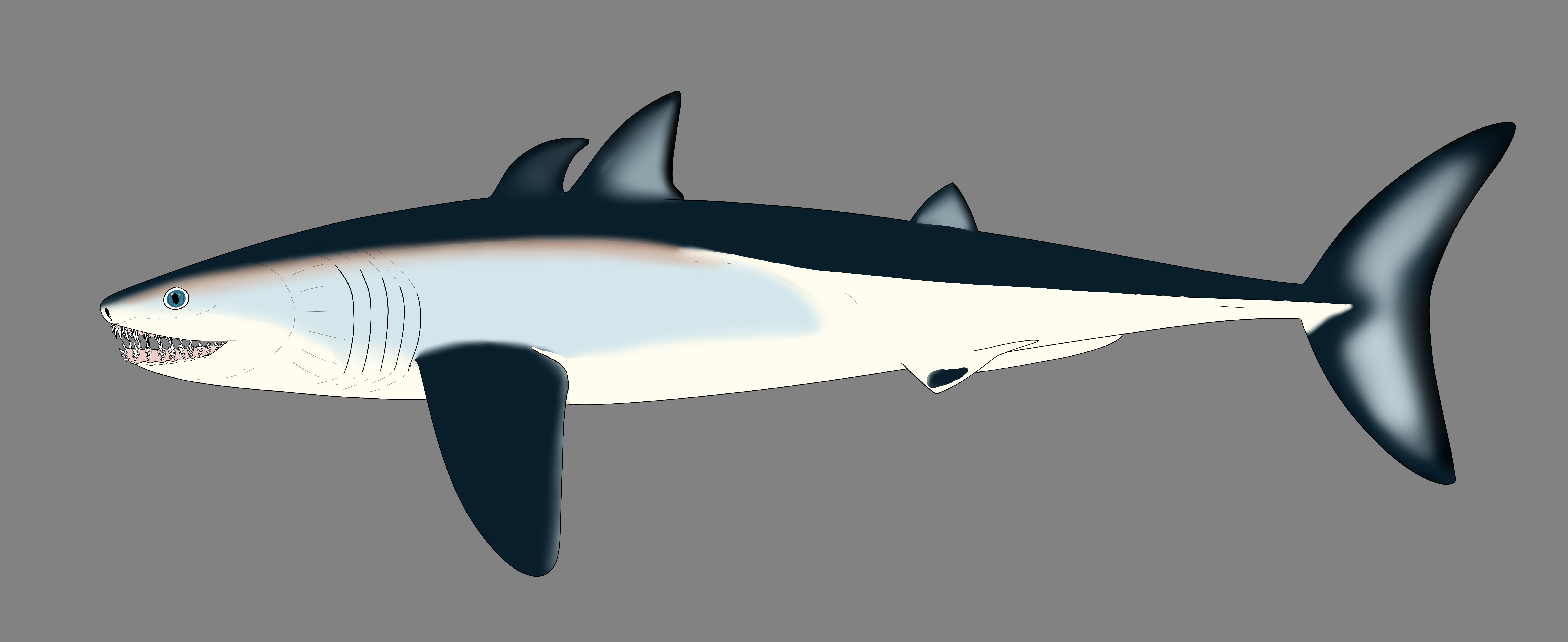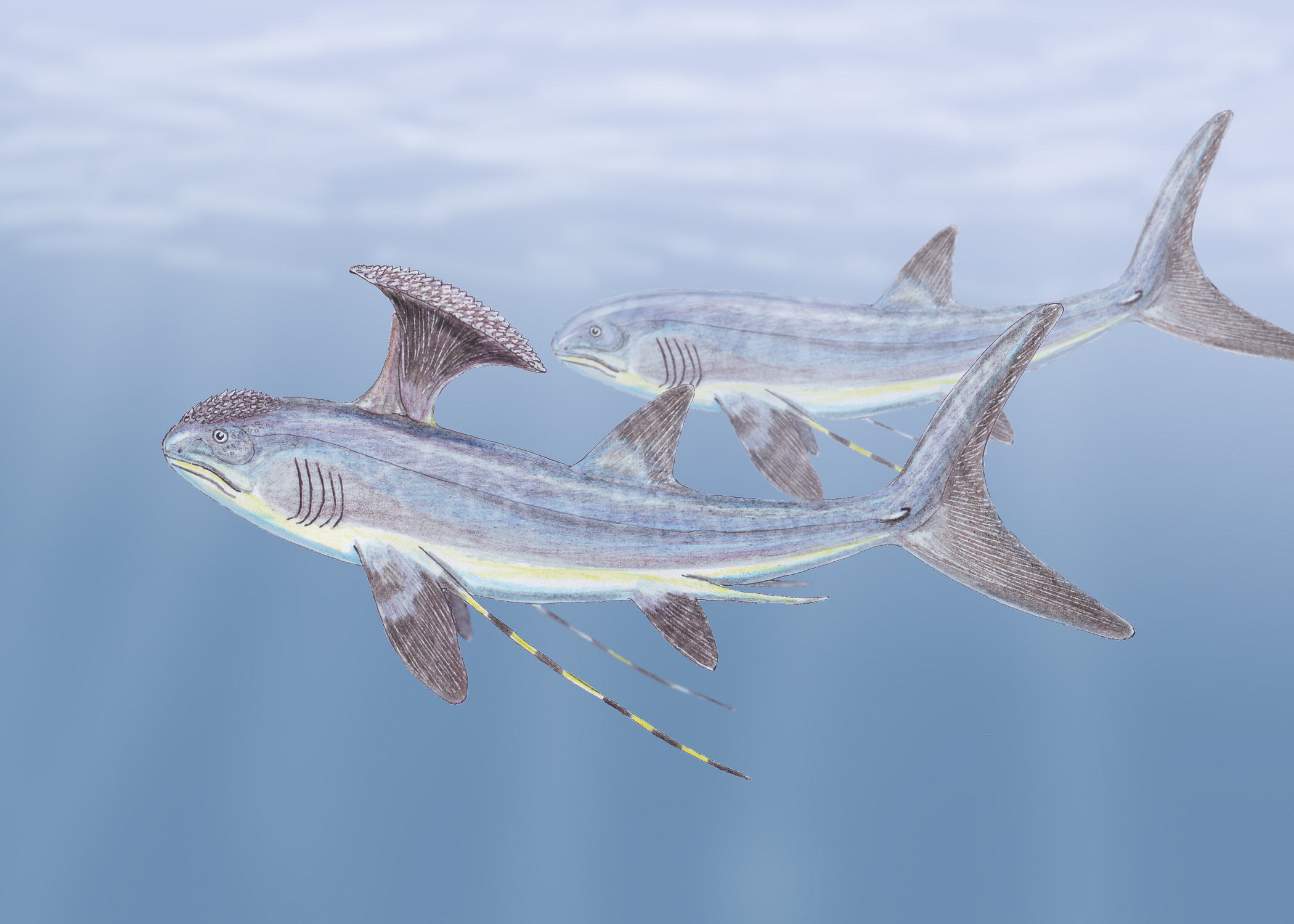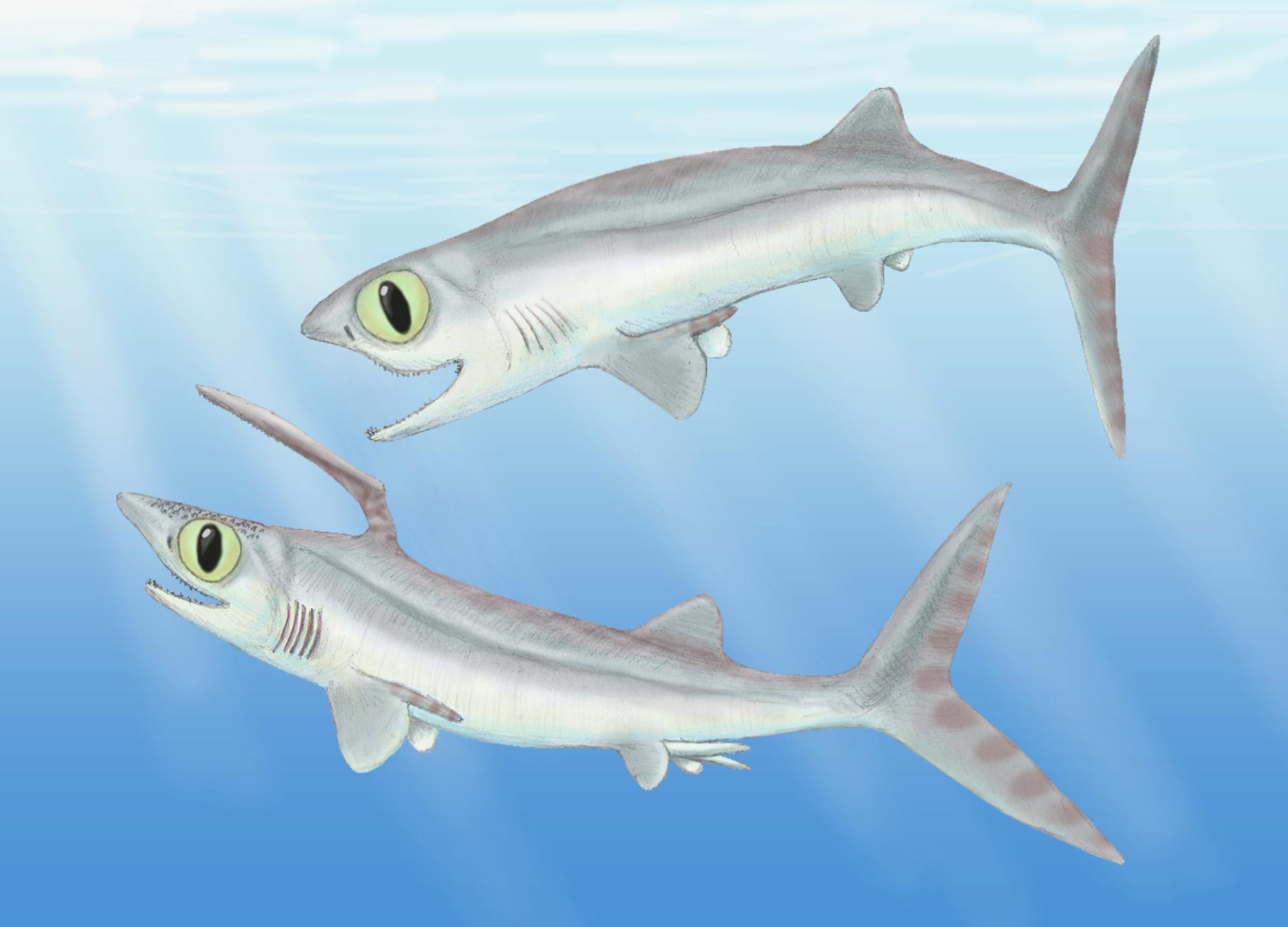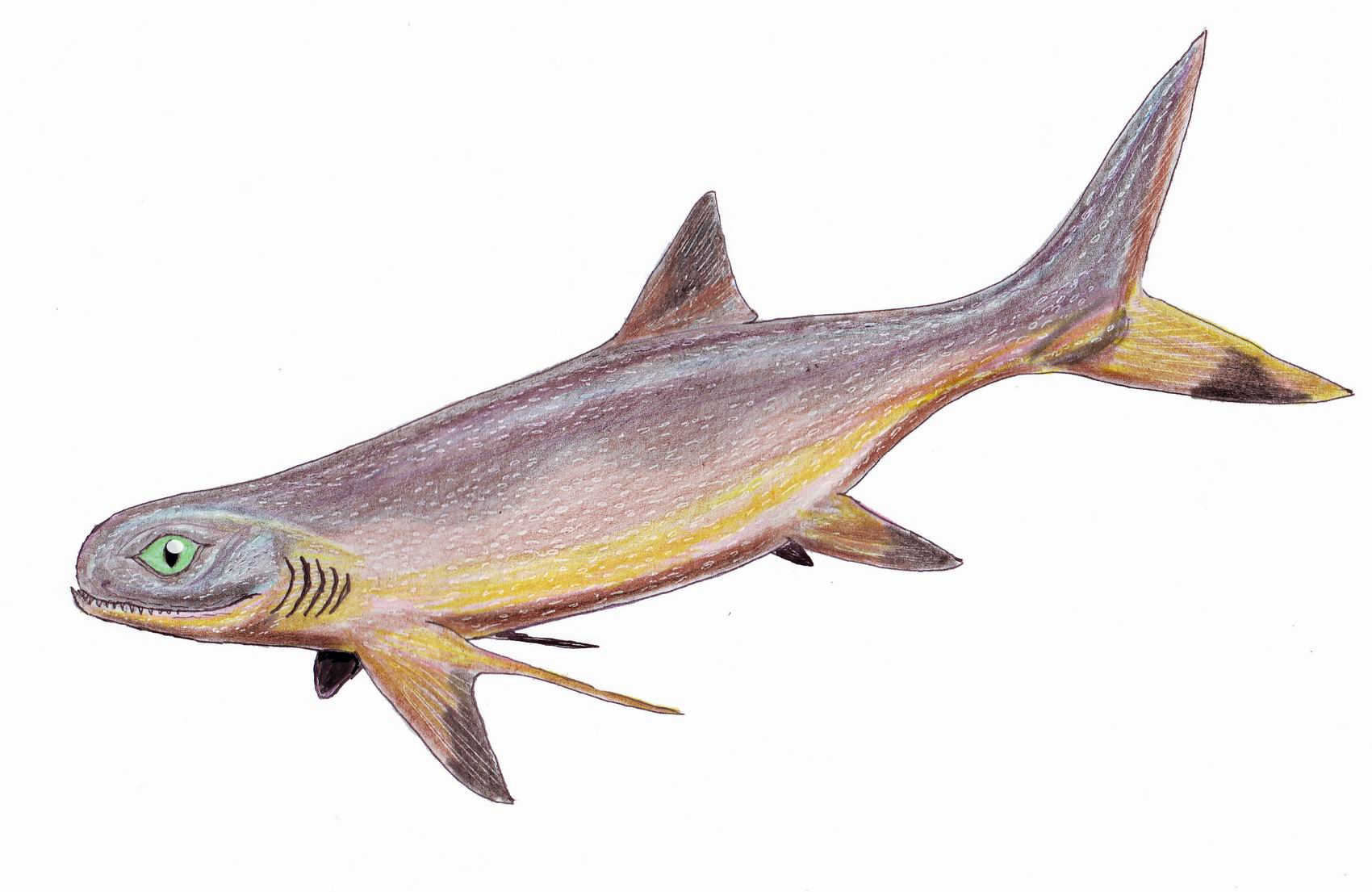|
Symmoriiformes
Symmoriiformes is an extinct order of holocephalians. Originally named Symmoriida by Zangerl (1981), it has subsequently been known by several other names. Lund (1986) synonymized the group with Cladodontida, while Maisey (2008) corrected the name to Symmoriiformes in order to prevent it from being mistaken for a family. The symmoriiform fossils record appear at the beginning of the Carboniferous. Most of them died out at the start of the Permian, but ''Dwykaselachus'' is known from the Artinskian-Kungurian of South Africa. Teeth described from the Valanginian of France and Austria indicate that members of the family Falcatidae might have survived until the Early Cretaceous; however, these teeth were also argued to be more likely neoselachian teeth. Fossil distribution Fossil evidence of Symmoriida have been found at Bear Gulch, Fergus County, Montana, Bethel Quarry, Pike County, Indiana, Kinshozan quarry, Alaska, Gifu Prefecture, Japan, Bashkortostan, Russian Federation and pos ... [...More Info...] [...Related Items...] OR: [Wikipedia] [Google] [Baidu] |
Cladoselache
''Cladoselache'' is an extinct genus of shark-like chondrichthyan (cartilaginous fish) from the Late Devonian (Famennian) of North America. It was similar in body shape to modern lamnid sharks (such as mako sharks and the great white shark), but was not closely related to lamnids or to any other modern (selachian) shark. As an early chondrichthyan, it had yet to evolve traits of modern sharks such as accelerated tooth replacement, a loose jaw suspension, enameloid teeth, and possibly claspers. Some 20th century studies considered ''Cladoselache'' to be a basal (early-diverging) member of Elasmbobranchii, the fork of cartilaginous fish which leads to modern sharks and rays. More recent studies have identified distinctive traits of the chondrocranium (cartilaginous braincase), dorsal fin spines, and pectoral fin bases. These newly identified features support a close relationship to symmoriiforms, a small group of bizarre chondrichthyans such as the bristle-spined '' Stethacanthu ... [...More Info...] [...Related Items...] OR: [Wikipedia] [Google] [Baidu] |
Stethacanthus Productus
''Stethacanthus'' is an extinct genus of shark-like holocephaliansCoates, M., Gess, R., Finarelli, J., Criswell, K., Tietjen, K. 2016. A symmoriiform chondrichthyan braincase and the origin of chimaeroid fishes. Nature. doi: 10.1038/nature20806 which lived from the Late Devonian to Late Carboniferous epoch, dying out around 298.9 million years ago. Fossils have been found in Asia, Europe and North America. Etymology ''Stethacanthus'' comes from the Greek στῆθος (''stēthos''), meaning "chest", and ἄκανθος (''akanthos''), meaning "spine" or "thorn". The name refers to the distinctive anvil-shaped first dorsal fin and spine displayed by mature males of the genus. Description ''Stethacanthus'' had different sizes depending on species, ''S. altonensis'' had length about , while ''S. productus'' reached . In many respects, it had a shark-like appearance. However, it is best known for its unusually shaped dorsal fin, which resembled an anvil or ironing board. Small s ... [...More Info...] [...Related Items...] OR: [Wikipedia] [Google] [Baidu] |
Stethacanthus Altonensis
''Stethacanthus'' is an extinct genus of shark-like holocephaliansCoates, M., Gess, R., Finarelli, J., Criswell, K., Tietjen, K. 2016. A symmoriiform chondrichthyan braincase and the origin of chimaeroid fishes. Nature. doi: 10.1038/nature20806 which lived from the Late Devonian to Late Carboniferous epoch, dying out around 298.9 million years ago. Fossils have been found in Asia, Europe and North America. Etymology ''Stethacanthus'' comes from the Greek στῆθος (''stēthos''), meaning "chest", and ἄκανθος (''akanthos''), meaning "spine" or "thorn". The name refers to the distinctive anvil-shaped first dorsal fin and spine displayed by mature males of the genus. Description ''Stethacanthus'' had different sizes depending on species, ''S. altonensis'' had length about , while ''S. productus'' reached . In many respects, it had a shark-like appearance. However, it is best known for its unusually shaped dorsal fin, which resembled an anvil or ironing board. Small s ... [...More Info...] [...Related Items...] OR: [Wikipedia] [Google] [Baidu] |
Stethacanthidae
Stethacanthidae is an extinct family of prehistoric holocephalians. It is estimated to have existed approximately between 380 and 300 million years ago. Members of this family are noted for their peculiar dorsal fin. Introduction The taxonomic history of the Family Stethacanthidae has been rather complicated because the findings of complete skeletons are very unusual, and as result early workers such as St. John & Worthen, and Newberry were unable to recognise the association of the spine, dentition teeth, and dermal denticles of these sharks. The genus ''Stethacanthus'' was established by Newberry (1889)NEWBERRY, J.S., 1889. The Paleozoic fishes of North America. ''United States Geological Survey Monograph'', 16, 340pp. for a series of large thin walled, cartilage-cored spines encountered in Mississippian (Carboniferous Period) rocks of the mid-continental United States. Decomposition of the internal cartilage and compression during burial resulted in distortion of the spines, ... [...More Info...] [...Related Items...] OR: [Wikipedia] [Google] [Baidu] |
Dwykaselachus
''Dwykaselachus'' (pronounced dwike-a-selak-us) is an extinct genus of symmoriiform, a cartilaginous fish that lived in what is now South Africa during the Permian period around 280 million years ago. It was first discovered in the 1980s, in a nodule of sediments from the Karoo Supergroup. ''Dwykaselachus'' was named based on Dwyka Group, the group of sedimentary geological formation in the southeastern part of Africa. It represents the place where the type species ''Dwykaselachus oosthuizeni'' was found. Prior to its discovery, symmoriiforms were thought to be related to sharks, in the group Elasmobranchii. However, CT scans of its relatively intact skull showed traits such as brain shape and inner ear structure that are shared with cartilaginous fish from the group Holocephali, which includes Chimaera, chimaeras. This implies that the first major radiation of cartilaginous fish after the Late Devonian extinction, Devonian extinction was in fact holocephalians, rather than shar ... [...More Info...] [...Related Items...] OR: [Wikipedia] [Google] [Baidu] |
Ferromirum
''Ferromirum'' is an extinct genus of symmoriiform fish known from the late Devonian (mid Famennian) Ibâouane Formation in the southeastern Anti-Atlas of Morocco, with a single species ''Ferromirum oukherbouchi''. It is known from a single well preserved skeleton, which is of a small individual less than half a metre in length. The jaws and hyoid arch are preserved uncrushed. The skull has large orbits (eye sockets) which have sclerotic rings. The teeth are small and have a cladodont This is a typical Cladodont tooth, of a shark called ''Glikmanius''">Glikmanius.html" ;"title="shark called ''Glikmanius">shark called ''Glikmanius'' Cladodont (from Latin cladus, meaning branch and Greek Odon, meaning tooth) is the term for a com ... morphology. The body is slender. The first dorsal fin has a smooth fin spine, which curves posteriorly towards its tip. References {{Taxonbar, from=Q116172894 Devonian sharks Symmoriiformes ... [...More Info...] [...Related Items...] OR: [Wikipedia] [Google] [Baidu] |
Falcatus
''Falcatus'' is an extinct genus of falcatid chondrichthyan which lived during the early Carboniferous Period in Bear Gulch bay in what is now Montana. Description This fish was quite small, only getting to around 25–30 cm or 10-12 inches long. This is about as big as some of the smallest sharks around today, like the pygmy laternshark. Falcatus was a chondricthian known as a "cladodont-toothed stethacanthid holocephalan". The first material known from the genus were the prominent fin spines that curve anteriorly over the head of the animal. When first described in 1883 from the St. Louis Limestone, these remains were given the name ''Physonemus falcatus''. However, in 1985, fossils of a new type of condrichthyan from Montana were described that displayed a high degree of sexual dimorphism. The same spines that were previously named ''P. falcatus'' were found on one of the morphs, identified as the male due to the presence of valvae.The morphology of ''Falcatus fal ... [...More Info...] [...Related Items...] OR: [Wikipedia] [Google] [Baidu] |
Kawichthys
''Kawichthys'' was an extinct genus of symmoriiform cartilaginous fish from Upper Pennsylvanian (Late Virgilian stage) deposits of Kansas, United States. ''Kawichthys'' is known from two well preserved three-dimensional neurocrania: the holotype KUVP 152144 is associated with some disturbed and broken postcranial elements, but the braincase is partially crushed, and the paratype KUVP 56340. It was collected from the Douglas Group, between the Haskell Limestone and the lower beds of the overlying Robbins Shale, previously classified as members of the Lawrence Formation or Stranger Formation, but now recognized as members of the extension of the Cass Limestone classification into Kansas. It was first named by Alan Pradel, Paul Tafforeau, John G. Maisey and Philippe Janvier in 2011 and the type species In zoological nomenclature, a type species (''species typica'') is the species name with which the name of a genus or subgenus is considered to be permanently taxonomically ass ... [...More Info...] [...Related Items...] OR: [Wikipedia] [Google] [Baidu] |
Symmoriidae
Symmoriidae is an extinct family of holocephalians from the Devonian and Carboniferous The Carboniferous ( ) is a geologic period and system of the Paleozoic that spans 60 million years from the end of the Devonian Period million years ago ( Mya), to the beginning of the Permian Period, million years ago. The name ''Carbonifero ... periods. References {{Taxonbar, from=Q2374629 Devonian first appearances Symmoriiformes Prehistoric cartilaginous fish families ... [...More Info...] [...Related Items...] OR: [Wikipedia] [Google] [Baidu] |
Falcatidae
Falcatidae is a family of Paleozoic holocephalians. Members of this family include ''Falcatus'', a small fish from the Bear Gulch Limestone of Montana. The family first appeared around the start of the Carboniferous, and there is some evidence that they survived well into the early Cretaceous, though its putative Cretaceous members were also argued to be more likely neoselachians. Genera *'' Denaea'' Ginter, M., Hampe., Duffin, C. 2010. Handbook of Paleoichthyology: Volume 3D- Paleozoic Elasmobranchii teeth. Verlag Dr. Freidrich Pfeil *''Falcatus'' *'' Ozarcus''? *'' Stethacanthulus'' *'' Cretacladoides''? – possible Early Cretaceous (Valanginian In the geologic timescale, the Valanginian is an age or stage of the Early or Lower Cretaceous. It spans between 139.8 ± 3.0 Ma and 132.9 ± 2.0 Ma (million years ago). The Valanginian Stage succeeds the Berriasian Stage of the Lower Cretace ...) member of the family References {{Taxonbar, from=Q19760083 Carboniferous ... [...More Info...] [...Related Items...] OR: [Wikipedia] [Google] [Baidu] |
Symmorium
''Symmorium'' is a dubious genus of extinct stethacanthid holocephalian from the Devonian and Carboniferous of the United States (Illinois) and Russia. The type species, ''Symmorium reniforme'', was named by Edward Drinker Cope in 1893 and several other species were originally classed under this genus, but they have since been classified into other genera such as '' Petalodus''. ''Symmorium'' bears close similarity in size and appearance to ''Stethacanthus ''Stethacanthus'' is an extinct genus of shark-like holocephaliansCoates, M., Gess, R., Finarelli, J., Criswell, K., Tietjen, K. 2016. A symmoriiform chondrichthyan braincase and the origin of chimaeroid fishes. Nature. doi: 10.1038/nature20806 ...'' but the former is missing the "spine and brush" on its back. Some paleontologists think that the two forms are simply the males and females of related species, while other scientists think they were distinct genera.M. Ginter, O. Hampe, and C. J. Duffin. 2010. Chondrichthyes, Pa ... [...More Info...] [...Related Items...] OR: [Wikipedia] [Google] [Baidu] |
Chondrichthyes
Chondrichthyes (; ) is a class that contains the cartilaginous fishes that have skeletons primarily composed of cartilage. They can be contrasted with the Osteichthyes or ''bony fishes'', which have skeletons primarily composed of bone tissue. Chondrichthyes are jawed vertebrates with paired fins, paired nares, scales, and a heart with its chambers in series. Extant chondrichthyes range in size from the 10 cm (3.9 in) finless sleeper ray to the 10 m (32 ft) whale shark. The class is divided into two subclasses: Elasmobranchii (sharks, rays, skates, and sawfish) and Holocephali ( chimaeras, sometimes called ghost sharks, which are sometimes separated into their own class). Within the infraphylum Gnathostomata, cartilaginous fishes are distinct from all other jawed vertebrates. Anatomy Skeleton The skeleton is cartilaginous. The notochord is gradually replaced by a vertebral column during development, except in Holocephali, where the notochord stays intact. In some deepwat ... [...More Info...] [...Related Items...] OR: [Wikipedia] [Google] [Baidu] |





